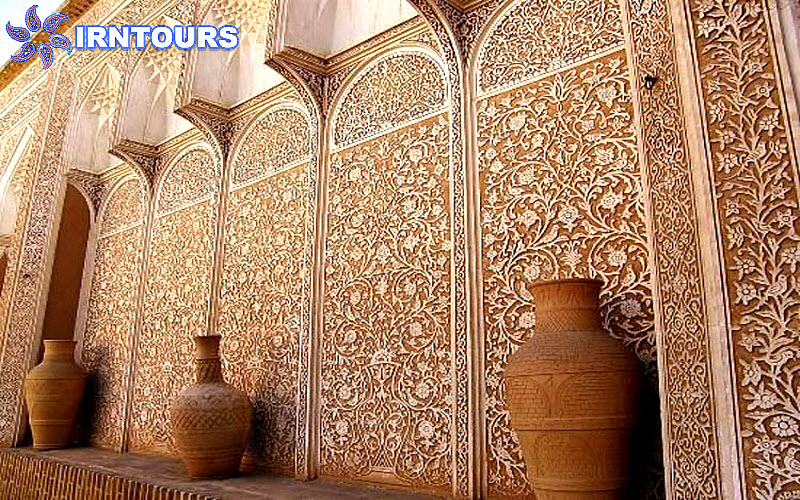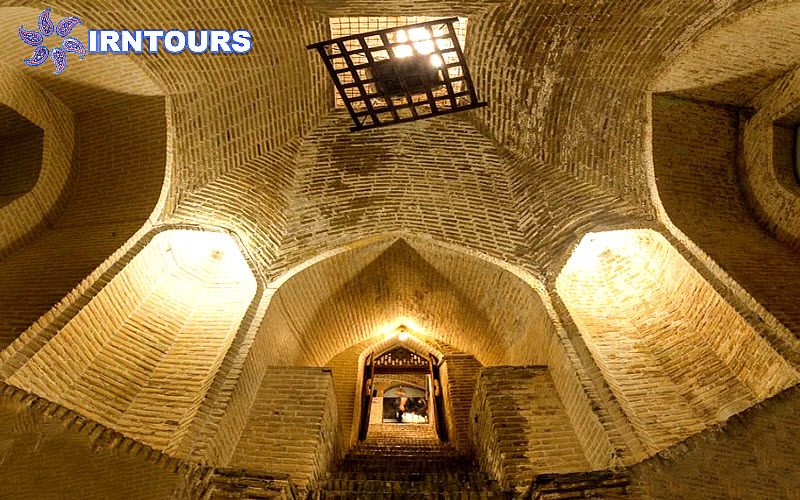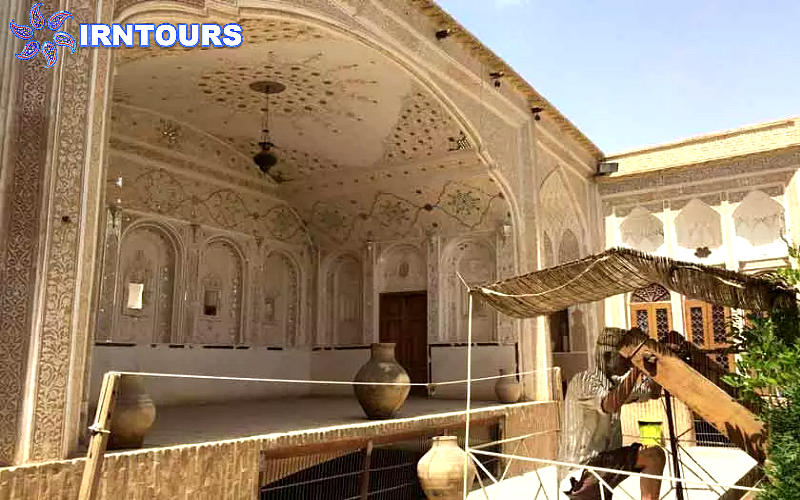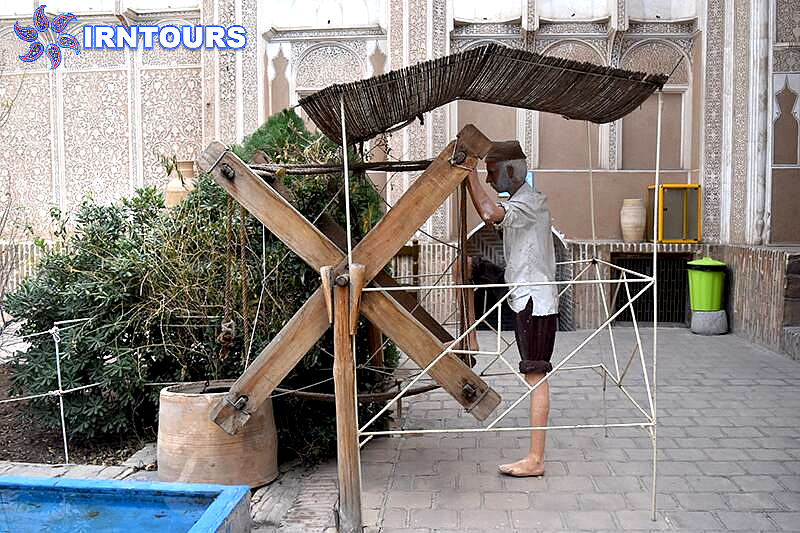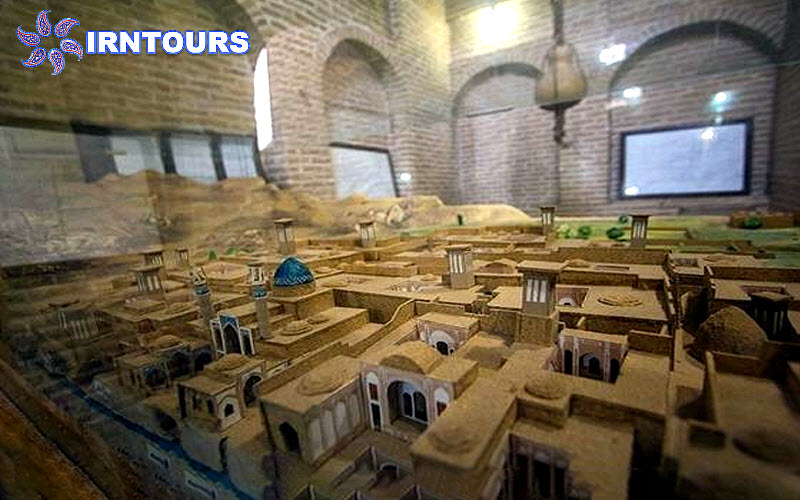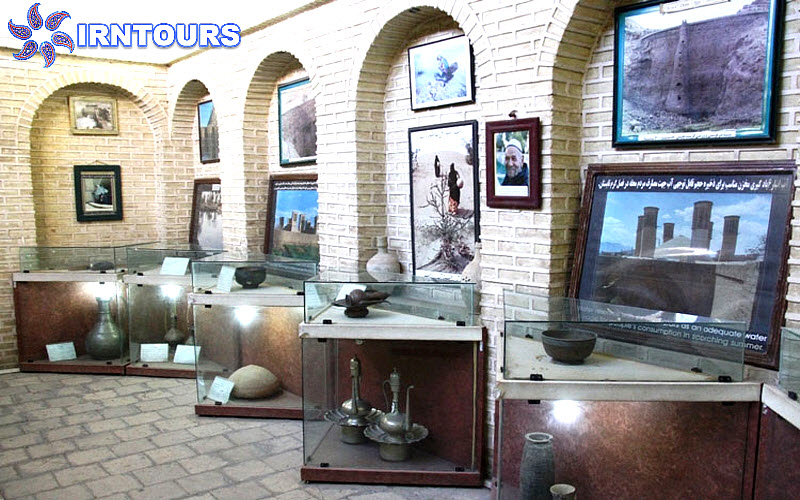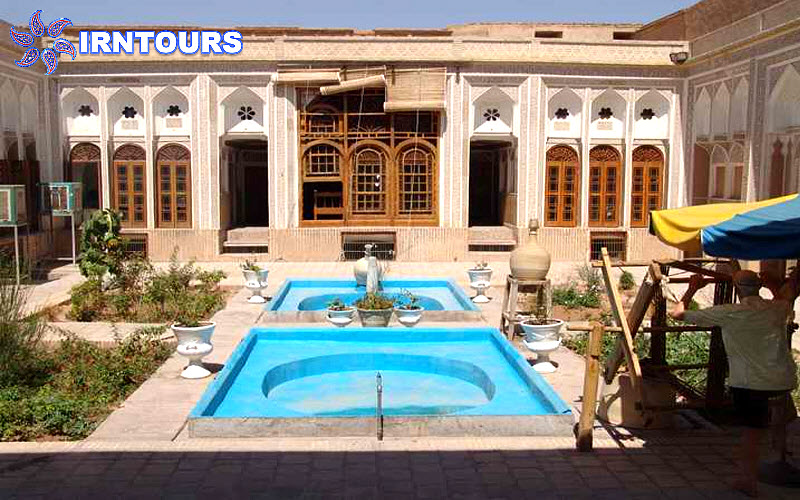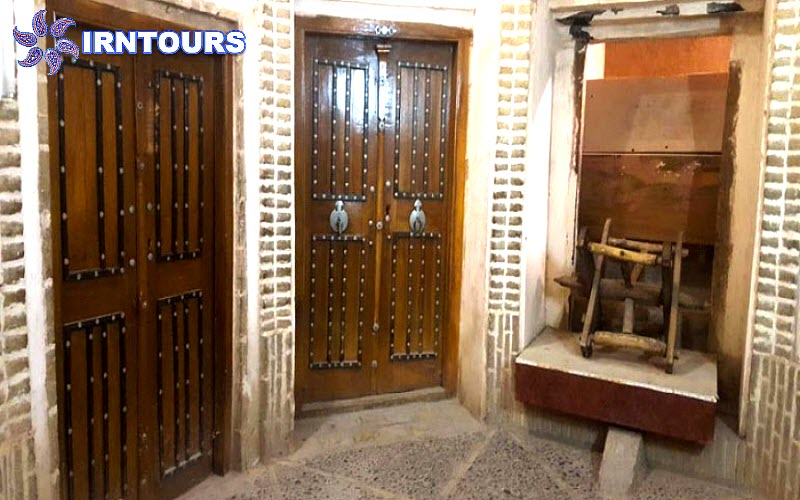About Yazd Water Museum
The Yazd Water Museum is located in the house of the Yazd tailors, and in it you can find various tools for digging aqueducts, tools and equipment for measuring water volume, lighting equipment in the aqueduct, documents and documents for buying and selling water and old waqf letters, mirab books and water distribution documents, containers See storage and transportation of water and many other related valuables. Also, a hundred-year-old stream passes through this house, and on its roof, there is a well, from which water was drawn by means of a well wheel and filled the house’s reservoir, which was located on the ground floor. Kolahdooz house was built on a land of 720 square meters by the order of the late Haj Seyyed Ali Akbar Kolahdooz, one of the merchants of the Qajar period, in 1849. It is located in the north of one of the most important places of interest in Yazd, Amir Chakhmaq Square.
House of Kolahdoozha
One of the most valuable and spectacular historical houses in Yazd, which is of high importance both historically and in terms of the importance of water in Yazd, the hatters’ house can be introduced to those who are interested in history and water. The construction of this beautiful and proud building for Iran began in 1811 at the request of the late Haj Seyyed Ali Akbar Kolahdooz, who was one of the famous merchants of the Qajar era in the center of Iran. The construction of this building lasted for about 3 years and ended in 1852. The historical house of Kolahdozha is now among the assets of Yazd Regional Water Company and it has been given the title of Yazd Water Museum. It is possible to visit this historical house and its spectacular museum for the general public.
Different Parts of the Kolahdooz House
The area of the Kolahdooz house is more than 720 square meters. This house has 5 floors or so-called 5 levels, which we will explain about each of them and their efficiency.
First level, negative 3rd floor in this house : The first level is the lowest floor of the house. Two branches of Rahimabad and Zarch rivers pass through this floor. It is interesting to know that the big and old aqueduct of Zarch is 75 km long and 2 thousand years old, and it is still active and dazzles the eyes of its viewers.
The second level, negative 2nd floor of the Hatters’ house : The second level of the hatters’ house is located at a depth of 10 meters from the ground level, which they used as a support and storage for the house. Payab is a place where the water of Qanat reaches the surface of the earth. The foot of this historical and beautiful house has a heptagonal space, and in its center is a blue basin through which Kariz water flows. In the past, the residents of this house used to wash their dishes and clothes in this place and it was very useful for them.
It will be interesting for you to know that the air temperature at this level remains constant throughout the year and it has a cool air! For this reason, in the past, this place was used to store food. There was a special method of storing food and snacks in this place, which is very interesting for people today. In this way, they put food on a wooden board and then hung it from the ceiling. The main reason for the coolness of the air at this level was the water of the aqueduct that passed through there.
Although the aqueduct water does not flow in this floor today, the temperature of this floor is still lower than the temperature of the environment outside it and it has still been able to maintain its use as a natural glacier of the house.
The third level of the house and the basement, which was the residence of the residents in the summer : The basement of this house is located on the third level of the hatters’ house. On the four sides of the courtyard, just below the rooms built on the ground floor, there are basements with numerous rooms and corridors. The residents of this house lived on this floor most days of the hot summer season, due to its lower temperature compared to the upper floors. It might be interesting for you to know that each room in the basement belonged to a special person and that the residents of the house each had their own room, just like the upper floor of this house.
The fourth level is the ground floor, which is the main residence of the residents in this beautiful house : The fourth level of the current Yazd Water Museum was the ground floor of the Kolahdooziha house, which included various sections, such as the sash room, the five-door room, the corridor room, the wind room, the hall and many others. This section has been the main residence of the residents of the historic Kolahdooziha house, and the residents spent most of their time on this floor in most seasons of the year. In the past, Haj Seyed Ali Akbar Kolahdooz along with his wife, children, daughters-in-law and servants all lived in this place. In the following, we will talk more about the rooms on the fourth level of this house and give explanations that are interesting for you.
Sash room on the fourth level of the historical house of Kolahdozan : A room with sash-shaped windows that opened from the bottom to the top was called a sash room. During the wedding of one of the children, this room was used as a bedroom and also as a guest house. Below the sash room, there is another room in the basement floor, which was used to store jars, pickle jars and vinegar in the past.
Five-door room on the ground floor : The five-door room of the Yazd Water Museum was the residence of the crew of this house and their sewing room. On the third level of this house, the basement floor, just below the five-door room, there was a large room that was used as a dining room for the family during the hot days of the year.
Hallway room on the main level of Kolahddoz’ House : Right next to the five-door room, there is a large room with very impressive and beautiful decorations, which used to be the personal room and residence of Haj Seyyed Ali Akbar Kolahdooz, and this is the reason for all the beauty in this room. After his death, the hall room was given to his wife and she became the owner of this luxurious room.
The windy room on the fourth level of Kolahdoozia House : On the other side of the five-door room, there is another room that used to have a windbreak and that is why it was named the windbreak room. This room was the residence of Mr. Kolahdoz’s daughter.
The hall of the tailor’s house is on the ground floor of this house : The hall of this house is a very large environment with a high and arched ceiling. In the beautiful dialect of Yazdi, the name of this place is Khenq Jai. It means a cool place to relax and spend hot days in summer.
Note: Each of these rooms has a storage room. Also, in all the rooms of this house, there is a small space known as the loft, where valuable things were kept, and it is one of the unique features of this famous and popular house in Yazd.
The fifth level of Hatters’ house is on the roof of the house known as the well house : The fifth level of the current Yazd Water Museum was the roof of the Kolahdooziha’ house. This part is known as the well house; Because this floor is where the well and the well wheel are located. In the past, they used the water of Chel Gaz wells for drinking, washing, health purposes and many other purposes through this well and the well wheel.
It will be interesting for you to know that at that time, two people were responsible for collecting water from a well-known aqueduct called Qanat Rahimabad, pulling the water up and then pouring it into a source so that the members of the house on the ground floor could have easy access to it for use.
Such a system is very similar to the water piping device of the present time, with the difference that the hatters’ house had such a system about 150 years ago and used it for the well-being of its residents!
In the historical museum of water in the beautiful city of Yazd, more than 200 different historical objects whose subject is water have been displayed for the visitors of this museum. In the following, we have explained about these works and objects.
A special tool used for digging aqueducts
As you know, aqueducts are the most important historical structures of Iranians, which are remembered and admired globally.
It is interesting to know that the name of the Iranian aqueduct is visible and shines in the list of UNESCO works. The Yazd Water Museum also exhibits various tools and equipment for digging aqueducts, special picks for digging aqueducts, well wheels, measuring clothes, instruments and tools for measuring water volume, lighting devices when digging aqueducts, and many other such tools. There is a carpet that shows how water circulates in the aqueducts. In this museum, there are also sculptures that show different people doing work related to their responsibility in the aqueduct.
Among these statues, we can mention the statue of Maghni (people whose work was digging aqueducts). The remarkable thing that attracts the visitors of this museum about these people is that their work clothes were white. The reason for the white color of their cover is that they can be seen well in the dark and large environment of the aqueducts and can recognize each other. Some likened the miners’ work clothes to a shroud, the reason for this resemblance is that they could fall at any moment while digging. Another important artefact that can be seen in this museum is the well wheel, this device was considered one of the most important tools for digging wells. Next to the well wheel, there is a statue of a well maker to give this museum a real color and smell.
Devices related to water distribution
Other works that are available in Yazd Water Museum can be mentioned the documents of buying and selling of water and old dedication letters from the time of Kolahdoozha house related to water. The booklet of mirabs and water distribution documents is one of the most special and interesting works in this department. Mirab in the meaning of the word means chief or amir of water. A person who used to distribute aqueduct water to different people was called Mirab. In the past, the Mirabs used a tool called a water clock to calculate the time to deliver water to each person. It is interesting to know that the world’s first blue clock, which is more than 700 years old, is kept in this museum. This water clock is one of the most valuable works in the Yazd Water Museum.
Among other documents in this museum, we can mention the marriage documents in which water was specified as a dowry, because at that time, water was as valuable as gold! There are also documents in this museum that show that some benefactors have given some of the water share to homeless and orphaned women.
Historical utensils and tools
Since there was no water piping in the past, people were forced to transport water for their various needs from the main source of water to their place of use. Also, in the past, most houses had a special place to store water.
In the Yazd Water Museum, many historical containers and tools that were used to store, carry water and similar applications are stored, which can be attractive for the visitors of this museum. Among these containers, we can mention various types of taps and tools for water collection from reservoirs, clay and glass containers for carrying and storing water, a string of saqai musk and many others. In this museum, there is also a several-thousand-year-old mashreba whose name appears in very old historical books.
Among other valuable works in this museum, we can mention a glass container that has side pipes. This glass container is double-walled, and in the distant past, this container was used to cool and purify water; In this way, some water was poured into it and snow was put on top of it. Gradually, the snow melted and finally cool, fresh and pollution-free water came out of the side pipes of the container for use.
Attractions near the Yazd Water Museum
There are other places around the Yazd Water Museum for tourism and enjoying the historical city of Yazd, including Amir Chakhmaq Square, Imamzadeh Shazdeh Fazil, Khan Yazd Bazaar, Panjah Ali Bazaar, Jame Kabir Yazd Mosque Clock Tower, Hashem Abad Historical House and He mentioned many other places in this city.
Access to the Yazd Water Museum
Address: Yazd Province, Yazd City, Imam St., North of Amirchakhmaq Square, Qiyam St
To access the Yazd Water Museum, you can use buses from Darvaz Quran Terminal-Shohada Mihrab Terminal to this attraction. Also, there is another way is to use the buses of Baath-Rahrahahn intersection and get off at Shahada intersection and you can reach this museum by walking a little.
Visiting time: from 08:00 to 19:00 (the museum is closed from 14:30 to 15:30)



